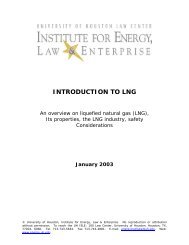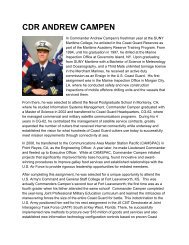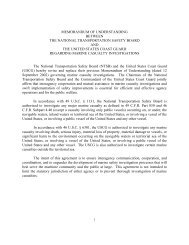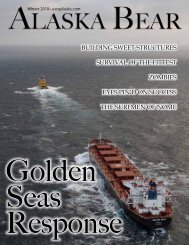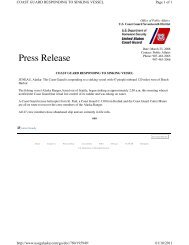marine board report - Off Soundings
marine board report - Off Soundings
marine board report - Off Soundings
Create successful ePaper yourself
Turn your PDF publications into a flip-book with our unique Google optimized e-Paper software.
Petty <strong>Off</strong>icer from the Marine Safety Detachment. The Marine Safety Information System case<br />
number for the inspection is MI99030162.<br />
Comment: If, as earlier Findings of Fact indicate, the ARCTIC ROSE actually engaged in<br />
operations making it a fish processor, then the Commercial Fishing Vessel Safety Examination<br />
(CFVSE) decal #74701 issued to the ARCTIC ROSE for Head and Gut operations would have<br />
been invalid.<br />
Finding of Fact 18.b, paragraph 1: At Sea Boardings. All vessels including commercial fishing<br />
vessels are subject to at sea <strong>board</strong>ings by the Coast Guard. The Coast Guard’s at sea <strong>board</strong>ing<br />
policy is outlined in ALDIST 062/92 and the MLEM Manual COMDTINST M16247.1. The<br />
ALDIST message provides guidance for the Coast Guard’s cutters to perform at sea <strong>board</strong>ings<br />
and details the safety equipment the <strong>board</strong>ing team should focus on.<br />
Comment: ALDIST 062/92 was cancelled before the February 25, 2001, <strong>board</strong>ing of the<br />
ARCTIC ROSE by the USCGC STORIS. The applicable reference at the time of the February<br />
25, 2001, <strong>board</strong>ing was CCGD17 LEB 00-007 (CCGD17 message 182334Z OCT 00).<br />
Finding of Fact 21, paragraph 1: The ARCTIC ROSE was engaged in “Head and Gut”<br />
operations. The processors remove the head (by hand or by guillotine) and entrails, then flash<br />
freeze the fish. Once frozen, the fish blocks are bagged and placed in the cargo hold for storage<br />
until they are offloaded ashore or to a tramper at anchor.<br />
Comment: Testimony provided during the hearing indicated that crewmen on the ARCTIC<br />
ROSE prepared fish in ways that by definition meant the ARCTIC ROSE was actually engaged<br />
in fish processing rather than only “Head and Gut” operations.<br />
Finding of Fact 21, paragraph 2: The H & G process does not meet the regulatory definition of<br />
processing and therefore, the ARCTIC ROSE was exempted from the Processing Vessel<br />
regulations found in 46 CFR Part 28, Subpart F. However, testimony by an ex-crew member,<br />
Mr. Rafael Olivaris, indicates that the vessel did indeed engage in fish processing by removing<br />
tails and fins and was subject to the regulations governing fish processing vessels. A vessel<br />
cannot arbitrarily change its status from non-processor such as H & G operations to processing.<br />
Once the ARCTIC ROSE engaged in processing, the regulations in 46 CFR Part 28, Subpart F<br />
applied. These regulations require a class society or other similarly qualified organization to<br />
conduct an examination of the vessel.<br />
Comment: Since testimony provided during the hearing indicated that the ARCTIC ROSE was<br />
indeed engaged in fish processing, it was not exempt from the Processing Vessel regulations<br />
found in 46 CFR Part 28 Subpart F.<br />
COMMENTS ON CONCLUSIONS<br />
Conclusion 9: The Marine Board identified a software error in the COMSAT system, which<br />
reduced the priority of the Safety Alert to a Navigation Warning without the sender’s consent or<br />
knowledge. The problem resided within the message routing software package for SafetyNET.<br />
3




